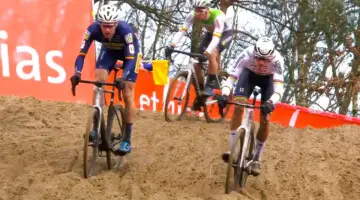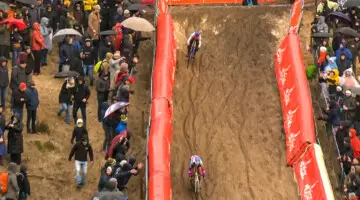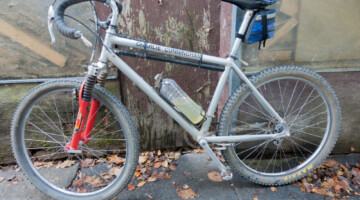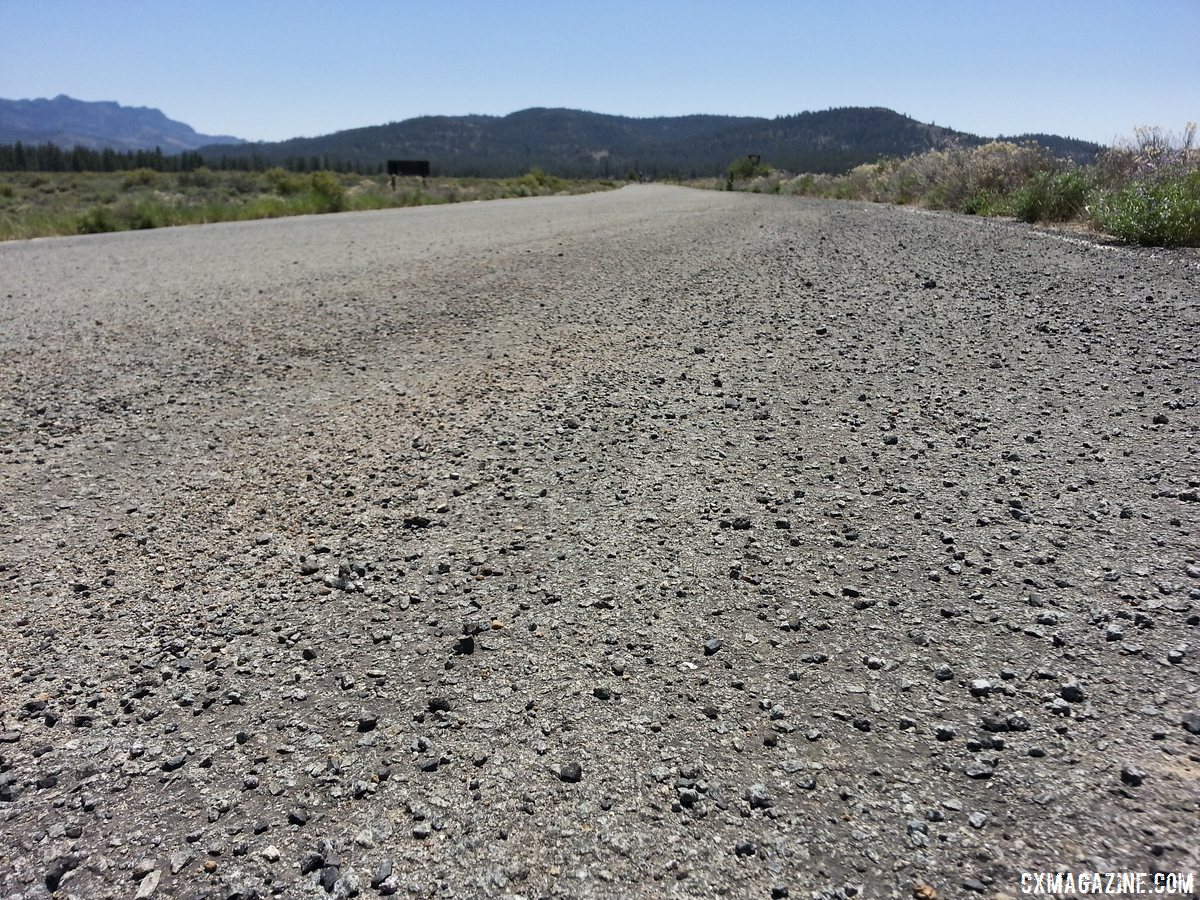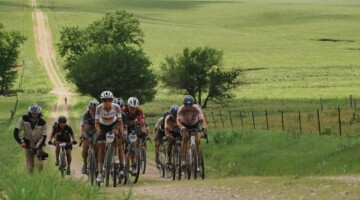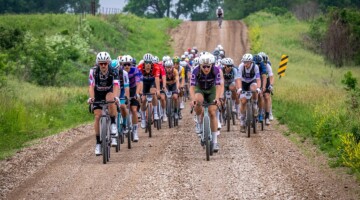Kansas native Brian Jensen transitioned from cross-country running to cycling in 2005 after graduating from the University of Kansas. A few years later, he won the Elite Race at the Tour of the Battenkill. He is no stranger to cyclocross, and every year he competes with ’cross legend Steve Tilford at the local races. Most recently, he not only took the win at the Dirty Kanza 200, but he also set a course record of 10 hours and 42 minutes, demolishing the previous record of just under 12 hours.
Cyclocross Magazine: Congratulations on a great 200-mile win!
Brian Jensen: Thank you very much! I want to say I could not have done as well as I did without my superb “pit-crew.” Also, Kent Eriksen had built me the most comfortable and reliable bike that carried me through the race without major issues making this a much better experience. TradeWind Energy is our team’s title sponsor and they support us in our needs as bike racers.
CXM: Can you tell us how the race played out?
BJ: The first 50 miles were by far the most eventful. We quickly formed a relatively large front group rolling along at a surprisingly casual pace. I had envisioned a faster start with guys not worrying about burning matches but most everyone seemed to be conservative and avoiding too much exposure to the wind. I was content with the pace.
The roads were very rocky and I had a constant fear of flatting. Dan Hughes was unfortunate to flat early on, which made the race much harder for him. After about 25 miles we went through a lot of mud that caused quite a bit of chaos and guys were trying to take the driest lines. I believe that is where Neil Shirley lost his rear derailleur. I opted to only use my front derailleur until we were past the few miles of mud.
Next was the largest water crossing which split the leading group up a bit. I think the guys riding through the water instead of dismounting had the most issues here. We continued through smaller water crossings before we got to the first sag.
My “pit-crew” was amazing. My wife, Michelle, my teammate, Bill Stolte, and my work college and former teammate, Nick Coil, refilled my food and water and cleaned my bike extremely quickly. It felt great leaving the sag and almost like starting a new 50-mile race.
The second 50-mile leg was less eventful. At about 65 miles a few of us start pulling harder and 5 of us left a larger front group. The group consisted of Berry Wicks, Jason Siegel, Josh Johnson, Jonathan Schottler and myself. We started rolling pretty fast to create a gap to the others. The guys were taking risks flying down the rocky downhills and I kept getting dropped and riding back up to them. My biggest concern was flatting and I was very cautious as to not hit any big rocks at speed. At mile 72 or so Berry got his second flat. We slowed down a bit knowing we needed his horsepower. Siegel flatted next followed by Schottler, and it was then just Johnson and me off the front. At mile 80 I decided to race my own race since I knew the miles ahead would include tailwind. I left Johnson and for the next 120 miles, I was all by myself.
My crew kept up their phenomenal work at the sags.
At mile 115, I had to get off my bike to reattach my bottle cage which had rattled off on the rough roads. At mile 125, I cut my rear tire, but my tires were tubeless with a large amount of sealant. So they sealed up at low tire pressure. I stopped and used a pump to fill a bit of air in the tire. They did not seem to hold the air, so I got back on the bike hoping the sealant would work its miracles and for the next 20 miles, I rode with low pressure. It sure was comfortable but a bit slower.
At mile 145, I used a CO2 to inflate the tire to about 40psi. Man, it felt good having good pressure back!
At the last sag I still felt really good and had no doubt I could win the race as long my equipment would hold. I ended up feeling good until about 15 miles to go. At that point, I think I had had too much water and my electrolyte imbalance caused me to feel nauseous. I started riding off course and even though I had a map on my Garmin, I easily got confused. Even back in Emporia I got off course and had to backtrack.
The finishing stretch was by far the best feeling. The crowd was unbelievable. The clapping and cheering were so loud, I finished with goosebumps all over. My pit crew and teammate Steve Tilford were at the finish together with a bunch of other friends congratulating me. I was so happy to be done and so relieved that everything went so extremely well.
CXM: You seem to spend a lot of time with criteriums and cyclocross races. What attracted you to entering a gravel grinder over such a massive distance?
BJ: Living in Lawrence, Kansas, I spent a lot of time riding gravel during the winter months. We have many group rides, sometimes led by the four-time winner of the DK200, Dan Hughes, that are done on cyclocross bikes and on really nice gravel roads. Gravel roads are much more interesting due to the increased amount of hills and better scenery. Also, there is almost no traffic to deal with.
The increased popularity of gravel racing over the past few years has for me a lot more interested in participating in these events and hearing my good friend’s Dan Hughes stories made me interested. I have always liked the longer and harder races on the road as opposed to short flat sprinter’s races. Gravel roads fit me well.
I must admit that I signed up thinking I wouldn’t actually do it, but with the registration filling up so quickly I wanted to at least have the chance to do it. Later my wife and friends really wanted me to do it so the last couple of months I changed my goals and training to prepare for the crazy long distance.
What I really like about doing this type of event is that I can focus on one race for a while and skip traveling to multiple road races around the country. I work as a civil engineer about 50 hours a week and that makes it difficult to travel to many races. This event is close to home.
CXM: Between your rig and the classic frame pump, it looks like you made some interesting choices for equipment. Can you walk us through building up your bike for the Dirty Kanza 200?
BJ: Last year Kent Eriksen built me a custom titanium cyclocross bike. Now I have an MTB, road bike, and a cyclocross bike all custom-built titanium by Kent Eriksen. These bikes ride really well both on and off the road and are very reliable. Kent has so much experience building bikes and knows exactly how to make the bikes stiff and comfortable – a racer’s dream. Most bikes are now carbon so in that aspect, this bike stood out as unique.
For tires, I used the 40mm wide Clement MSOs and set them up tubeless on Bontrager aluminum wheels. These tires are heavy and big, but my biggest concern was to avoid flatting. It turned out that tubeless was the key to avoiding flatting for me.
And it’s funny you mention the pump. I bought a really small sexy pump to use, but with 40mm tires, it would take me way too long to fill up a tire. The pump I ended up using is one I’ve had for years and it’s pretty much as light as the small one I replaced it with. Again reliability and functionality trumped looks and weight.
CXM: Did you know you were on the verge of beating the course record during the race?
BJ: It wasn’t until really late in the race that I realized it. I was going by miles and not by time. Not until I started feeling nauseous did I start calculating my finish time and how much more time I had left. When I realized that I would finish in under 11 hours I got really excited and got fueled with more motivation.
CXM: Do you have any other gravel grinders lined up for the rest of the season?
BJ: Not at this point. My next big race is Leadville 100 which I will do together with the rest of my teammates at TradeWind Energy Cycling Team.
Stay tuned for more gravel grinding action from Cyclocross Magazine!










